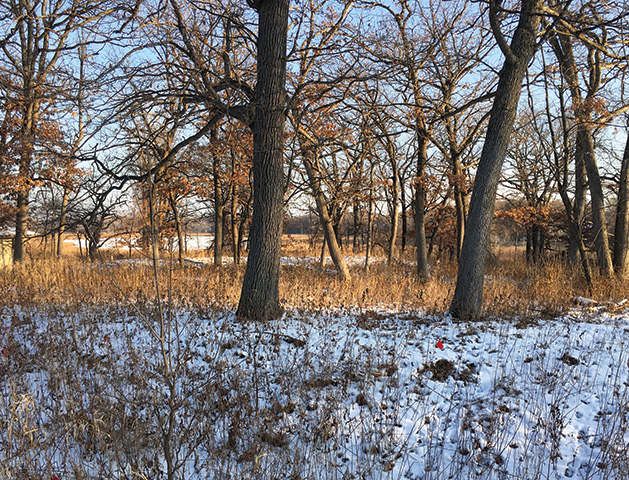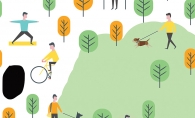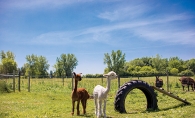
Devoting their time to preserving native plant communities, ecological restoration company Prairie Restorations, Inc. (PRI) aims to maintain the beauty, ecological soundness and environmental benefits of natural vegetation all over Minnesota.
“No matter where we’re working across the state, our goal is to utilize the same species that would’ve been found there before people came around and started altering the land,” Erin O’Leary, site manager at the Two Oaks office in Scandia, says.
Back in 1977, the company solely focused on prairie restoration, hence the name, but expanded to anything from prairies and shorelines to wetlands and woodlands. It all started with three employees and a single location. Now, PRI operates with a full-time staff of 45 in seven locations throughout Minnesota. Their services also extend to Wisconsin, North and South Dakota and Iowa.
Over the past few decades, PRI has restored more than 25,000 acres of prairies, wetlands and woodlands. They’ve worked on locations including corporate grounds, golf courses, public grounds, residential developments and agricultural fields. Along with consulting, installation and management services, PRI operates retail stores at their Scandia, Princeton and Munger locations. They offer seeds, plants, shrubs and trees from their greenhouses and bird supplies, local art and children’s gifts in their gift shop.
When beginning a project, PRI references maps and information garnered from records from the 1800s, before Minnesota was a state, O’Leary says. “We ... reference that information so that we are utilizing plant material that would be found native to the area we are working in,” she says.
PRI uses this information to make decisions because the plants establish themselves best in these areas, O’Leary says. It’s easier for native plants to thrive where they used to exist--the soil has already been proven to support the plants.
Native plants bring beauty to the environment and are less expensive to install and maintain than horticultural landscapes (gardens). “The beauty in native plantings is … the simplicity of it all,” O’Leary says. “It requires no soil amendments, no fertilizers and no additional water, with the exception of establishing new plant material.”
The beauty of native plants lasts throughout the seasons. “A diverse native plant community has something that is blooming throughout the growing season,” Simba Blood, natural resources technician for the Ramsey-Washington Metro Watershed District, says. “Even when they’re dormant, you get a really rich variety of colors of reds and browns and golden hues in our snow-covered landscapes.”
Not only do native plants make property owners’ lives easier and beautify spaces, but they offer plenty of environmental benefits. Prairie vegetation is a strong option for the next biofuel source to create electricity and ethanol, according to PRI. In addition, native vegetation combats global warming by keeping carbon in the soil.
There are many benefits to native plants, but one of the most popular reasons people choose them is the benefit they provide to wildlife, O’Leary says.
“There are numerous insects that have relationships with certain specific species of plants and flowers,” O’Leary says. “Without that insect helping that plant, not only will the insect decline, but the plant species will decline, too.”
The monarch butterfly prevails as a poster child for a reliance on native plants. The butterfly has evolved with the milkweed species, meaning the larva from the butterfly can only feed on milkweed plants. Without milkweed, the butterfly species declines.
Various relationships between insects and native plants exist, but it extends beyond that. “You have certain birds that rely on those specific insects, which rely on those specific plants,” O’Leary says. “So it’s not just saving monarchs or saving canard blue butterflies, you’re literally trying to save a whole ecosystem that relies on a specific plant species.”
The ecosystem relies on intricate and delicate relationships between plants, insects and birds. Invasive species threaten their survival. “If you lose that insect, you also lose that plant or vice versa, and then we don’t even know what repercussions losing that plant will have on other parts of the ecosystem,” O’Leary says.
PRI works on projects that require the removal of invasive species, such as buckthorn and thistle, so native plants can flourish. Techniques including prescribed burning, a method that uses controlled fire to restore natural vegetation, and integrated plant management, which uses plant management techniques and targeted timing, help PRI encourage growth of native plant communities throughout the region.
Monitoring and eradicating invasive species is one of PRI’s most important services to bring back native species. “The biggest challenge that we have with native plants are the non-natives or invasive species that are very capable and can very quickly push out natives,” O’Leary says.
In North Oaks, Minn., an effort to oust buckthorn and thistle to make way for a variety of native plant species persists. Damien Lepoutre, a resident and property owner in North Oaks, and his wife continue to work on a three-year project with PRI to support native vegetation and growth in certain areas of their property.
BUCKTHORN INFESTED

RESTORED

Before discovering PRI, Lepoutre took most of the buckhorn out. “Once we took the buckthorn out, we knew that we needed to make sure that we had experts that would help us make sure the [species] will regrow in a natural way with natural vegetation,” he says.
Lepoutre talked with many landscapers about the project, and most of their clients designed something more urban involving a garden or flowers. His focus on a natural approach to landscaping led him to PRI.
“[PRI has] this approach of understanding the natural species and the equilibrium that’s there,” Lepoutre says.
Lepoutre and his wife moved back to France after living in the western suburbs of Minneapolis 18 years ago. After moving back to Minnesota five years ago, they decided to live in North Oaks because of the community’s prominent wildlife and natural environment.
“North Oaks [appealed] to us because the community has a goal of retaining the natural environment, and we liked this approach,” Lepoutre says. “We need to better educate people to be careful...[and make sure they don’t alter] the natural equilibrium.”
“[Lepoutre] is very conscientious of being a good land steward and setting a good example,” O’Leary says.
When Lepoutre and his wife moved to their North Oaks home, it already had a lawn put in but most of the lot remains wooded. “What is lovely...is that he has a beautiful oak woodland that has an amazing native plant population already naturally existing,” O’Leary says. “The woodland habitat is unique and not what people think about normally when they think of a native landscape.”
Many native species currently grow on the property including wild geranium, Virginia waterleaf and calico aster. PRI will place more graminoid (grass) species, like sedges and shade tolerant grasses, to further diversify the native plant community. They also aim to rescue native shrubs like native bush honeysuckle.
The project began last summer with preparation...for replanting on the land, but the management of the buckthorn in the area began last fall. The project is taking place over a period of years because of buckthorn’s tolerance of shade, ability to quickly grow, seed that can remain dormant in the soil for up to a decade and the chemical it can leave behind to inhibit the germination of other seed in the soil, O’Leary says.
Lepoutre’s project possesses the two types of buckthorn: common buckthorn (Rhamnus cathartica) and glossy buckthorn (Frangula alnus). Their property contains common buckthorn throughout, which is common in Minnesota woodlands and forests. Glossy buckthorn grows in wetter areas. “Both of these...are capable of spreading quickly [through] berries that birds love,” O’Leary says.
PRI plans to manage out the thistle and the buckthorn. The invasive species, O’Leary says, adapt to grow at times opposite the native species and then is spread, primarily by birds.
“This project...like others, needs maintenance...because there is always a source for these invasive species,” O’Leary says. “If left unchecked, we get back into the same situation that was on a site when we [began]....”
Wild parsnip is another invasive plant.“The sap can [cause]...severe burns,” Blood says. “This is a plant that people should be as or even more familiar with than poison ivy because it can be a real hazard.”
Wild parsnip is most abundant in southeastern Minnesota but is in most of the state, according to the Minnesota Department of Natural Resources. It spreads mainly by seed through mowing equipment. “Last year, a woman in Minnetonka got...severe burns just walking [in a] field,” Blood says.
With invasive plants removed, native plants can take their place in the ecosystem. If you want to grow native plants, Blood says, it’s vital to learn which plants work best together to avoid one outcompeting the other. “...[M]ake sure you match your habitat and your aesthetic with the plants you select,” Blood says.
Benefits of “Going Wild”
- Soil rehabilitation, water retention and wildlife habitat improvement.
- Adds color, light, texture, sound and motion.
- More economical than horticultural landscapes.
- Native plants “lock up” carbon, which helps fight global warming.
Prairie Restorations, Inc.
21120 Ozark Court N., PO Box 95, Scandia
651.433.1435
Facebook: Prairie Restorations - Restoring and Maintaining Native Plant Landscapes









